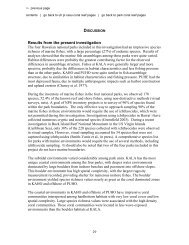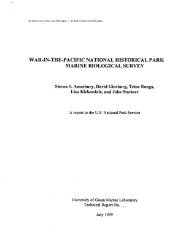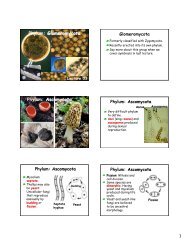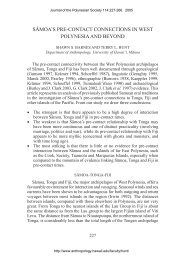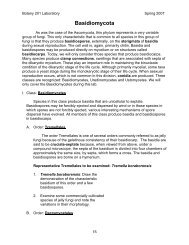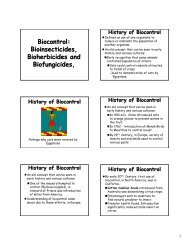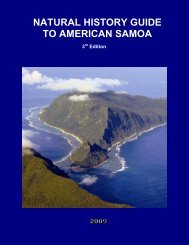american samoa - University of Hawaii at Manoa Botany Department
american samoa - University of Hawaii at Manoa Botany Department
american samoa - University of Hawaii at Manoa Botany Department
- No tags were found...
Create successful ePaper yourself
Turn your PDF publications into a flip-book with our unique Google optimized e-Paper software.
Project ManagerRepresent<strong>at</strong>ives <strong>of</strong> any <strong>of</strong> the particip<strong>at</strong>ing agencies would logically serve as individual projectmanagers. For example, if the primary thrust <strong>of</strong> a project is to enhance aqu<strong>at</strong>ic fish andinvertebr<strong>at</strong>e habit<strong>at</strong>, the selection <strong>of</strong> a project manager from the ASG <strong>Department</strong> <strong>of</strong> Marineand Wildlife Resources would be ideal if qualified personnel were available to assume thisresponsibility.The project manager would direct the activities <strong>of</strong> a village project coordin<strong>at</strong>or andrecommended Stream Team, coordin<strong>at</strong>e with traditional village leaders and residents livingadjacent to the selected stream or wetland, and coordin<strong>at</strong>e with represent<strong>at</strong>ives <strong>of</strong> other ASGagencies.Village Coordin<strong>at</strong>orThe approval and commitment <strong>of</strong> local villages to each enhancement and restor<strong>at</strong>ion project isessential. The commitment <strong>of</strong> a local village coordin<strong>at</strong>ors to this responsibility will, in largepart, depend upon their understanding <strong>of</strong> resource rel<strong>at</strong>ionships and potential streamenhancement benefits.A village coordin<strong>at</strong>or, e.g., pulenuu or m<strong>at</strong>ai, would be assigned to each project to:• organize and mobilize Stream Team cleanup and long-term stream maintenance activities;• observe and document stream and wetland conditions during and following future stormevents;• monitor the conditions <strong>of</strong> other resources, e.g., veget<strong>at</strong>ion, fish and invertebr<strong>at</strong>es; and,• keep the overall project manager abreast <strong>of</strong> work progress.Stream and Wetland TeamsAmerican Samoans are well known for their excellent ability to work collectively in groups.The use <strong>of</strong> small Stream or Wetland Teams can capitalize upon these capabilities.Where recommended, stream and wetland Teams <strong>of</strong> various sizes should be organized andemployed by ASEPA or ASCMP to initially clean up selected stream channels and wetlands, aswell as provide long-term monthly maintenance. These teams should only be establishedwhere stream or wetland cleanups are necessary to initi<strong>at</strong>e other restor<strong>at</strong>ion and enhancementprojects. It is envisioned th<strong>at</strong> their work would, in some cases, be supplemented by heavyequipment support from the American Samoa Power Authority or the ASG <strong>Department</strong> <strong>of</strong>Public Works.Stream and wetland teams would ideally be comprised <strong>of</strong> members <strong>of</strong> the village aumaga, orother village residents. Each team member could be supplied with <strong>at</strong>tractive T-shirts, caps,pants, and/or boots th<strong>at</strong> identify th<strong>at</strong> they are part <strong>of</strong> a specific stream team, e.g., Papa StreamTeam. The use <strong>of</strong> some type <strong>of</strong> informal uniform should be considered to bring about somecamaraderie among these employees. Uniforms for these personnel would also help advertisethe project to local residents as these employees work in local streams and wetlands.American Samoa Wetland/Stream Restor<strong>at</strong>ion and Enhancement PlanFebruary 2001, Future Program Management, Page 12-2




